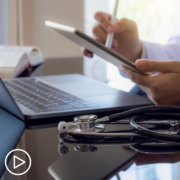Tag Archive for: televisit
An MPN Expert’s Top Three Tips for a Telemedicine Visit
An MPN Expert’s Top Three Tips for a Telemedicine Visit from Patient Empowerment Network on Vimeo.
As a myeloproliferative neoplasm (MPN) patient, what steps can be taken to prepare for telemedicine visits? Expert Dr. Jamile Shammo from Rush University Medical Center provides her key tips to help ensure an optimal telehealth visit.
See More From the MPN TelemEDucation Resource Center
Related Resource:
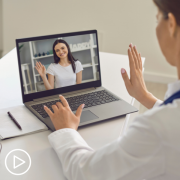
|
Transcript:
Dr. Jamile Shammo:
When preparing for a televisit, I think it’s so important to know whether or not you would have a connectivity issue. A lot of times I’m trying to connect with the patient and then we realize that their phone isn’t equipped to handle the televisit and that is kind of disappointing to find that out a minute before you try to connect then that visit becomes a telephone encounter, which is again, less satisfying for some patients. I mean it does the job, but again, it doesn’t provide me with the exam…part of the exam that I’d like to do, at least in that way. So, I think prepare yourself and make sure that your device is able to connect and actually most clinics will have a person that may be able to help you navigate through the televisit pieces that would help you get through and connect with the provider, and then obviously with an MPN or any other visit, patient with a heme malignancy, it would be helpful to make sure that you have a blood draw or if your physician would like to have a blood draw in my case, I always like to have a CBC beforehand or perhaps a chemistry or maybe ion studies or what have you, to have that so that there will be something to discuss and make sure that your physician has had those results before you have the visit.
Sometimes it is also disappointing that the patient thinks I’ve received those results when I actually haven’t and I have no control over that, so that would be the other piece. All of us do our best so that we can make sure that all those pieces are in place so that we can conduct the visit. And I know it’s a lot of work on everybody’s part. But in the end, what matters is that we are providing the best care possible in those very challenging times.
What Opportunities and Challenges Does Telemedicine Present for MPN Patients?
What Opportunities and Challenges Does Telemedicine Present for MPN Patients? from Patient Empowerment Network on Vimeo.
For myeloproliferative neoplasm (MPN) patients, what does telemedicine offer in terms of opportunities and challenges? Expert Dr. Jamile Shammo from Rush University Medical Center shares situations when telemedicine versus in-person visits can help provide optimal MPN patient care.
See More From the MPN TelemEDucation Resource Center
Related Resource:

|

|
Transcript:
Dr. Jamile Shammo:
I think the medicine has provided a tremendous opportunity for us to take care of patients in general, MPN patients in particular during the pandemic. We obviously wanted to minimize the exposure of patients to COVID during the pandemic, but patients who have MPN as well as other hematological malignancies needed to have CBCs frequently to make sure that the treatments that they were on were safe, that they were doing what they were supposed to do in terms of controlling their counts. So, then there was no escaping that. And they also needed to get ahold of their doctor, so being able to do both, perhaps away from the hospital in some type of clinic and being able to connect with the physician online to discuss the results of the CBC that they had obtained in perhaps a less populated lab was tremendous. And granted, this had made it feasible to care for patients during the pandemic. But now that we are sort of emerging from the pandemic, people are realizing that perhaps those technologies are there to stay, and perhaps there’s a subset of patients that may still be able to benefit and take advantage from those resources, so we are learning as we go who may be able to continue to do this.
I have to say though, that that may not be for every patient, and I still feel like there’s a particular type of MPN patient that will benefit from seeing the physician and having a full exam once every so often. And we can talk about the particular application that that may be, but granted telemedicine has certainly provided a tremendous advantage during COVID.
So, when I think of the patient that might benefit most from seeing the physician via televisit, for example, it would be someone who perhaps has a stable disease. Someone who I may want to monitor perhaps every three to six months, someone who may have stable counts, and we’re just talking to about their symptoms and monitoring those types of things every so often. And perhaps I look at the labs and you can discuss their symptoms and whether or not they have splenomegaly and issues like that. Someone who may already be on a stable dose of medication and we don’t have to do any dose adjustments and even if we have to do those adjustments, perhaps we could do labs a little more frequently, so that would be all right too, but someone in whom I would like to initiate in treatment, someone in whom the disease may be progressing a little too quickly, someone who I may want to do an exam and assess their spleen, I suppose you could send them to an ultrasound facility and obtain an MRI or a CT, or an ultrasound of the imaging study that is. But there’s nothing like an actual exam of the patient. You are thinking about the disease progression, so those sorts of patients in which the disease is actually changing its pace, you may want to take a look at it, the full smear look and examine the skin for certain TKI and signs and symptoms of low platelets and that sort of thing. Look in the mouth for ulcers and things of that nature. Those are the patients that I feel like would benefit the most from seeing their physician of course, the patient who has questions and that that could be probably beyond what a televisit could do. I think those would be the types of situations where you would like to have a physical presence and discuss things that would be of extreme importance to the patient’s physical health, psychological health, and of course, labs that you may want to obtain beyond the regular CBC that a standard lab could obtain outside of your institution. There are specialized labs that not every leg outside of your own tertiary care center may be able to provide, and that is something that we need to all the time. Let’s say a patient may require a bone biopsy, well then you have to have them physically be in your place, and then you might as well, then see them, examine them and do all of the labs, and that’s the other thing that we would like to do is perhaps to bundle all of the tests that you would be minimizing the exposure of patients to frequent visits so that you would be again, lessening the exposure, potentially infections.
What Impact Does Telemedicine Have on Clinical Trials for MPN Patients?
What Impact Does Telemedicine Have on Clinical Trials for MPN Patients? from Patient Empowerment Network on Vimeo.
For myeloproliferative neoplasm (MPN) patients, what impact does telemedicine have on clinical trial access? Expert Dr. Jamile Shammo from Rush University Medical Center explains the current environment for clinical trial access and her perspective on how trial access should be approached in the future for improved MPN care.
See More From the MPN TelemEDucation Resource Center
Related Resource:

|

|
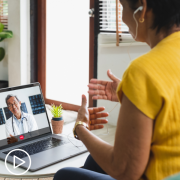
|
Transcript:
Dr. Jamile Shammo:
So, there’s no doubt that COVID has certainly impacted our ability to enroll patients on clinical trials. There have been a lot of governing bodies that have created various rules and regulations around that to facilitate enrolling patients on clinical trials, and I think right now we are seeing that this has become feasible, such that we are able to enroll patients yet again on the clinical trial. So, now I think that we have the vaccine that is available, it has become a little bit more feasible and possible to do so. So, this should not stop us. I think we should continue to seek better treatments for MPN patients actually the only way to do so is by you know, only patients on trials, because we certainly don’t have a perfect way to provide care at the moment, we always need to come up with better ways and that would be one way to do so.
The MPN community truly should partner with their physician and learn as much as possible about their disease and about available treatment options, and perhaps show some support for available clinical trials because this is the only way that we can perhaps understand how we can do a better job in treating patients who have MPNs.
What Multi-Language Technology Innovations Are Available for Cancer Patients and Families?
What Multi-Language Technology Innovations Are Available for Cancer Patients and Families? from Patient Empowerment Network on Vimeo.
What are available innovations for chronic lymphocytic leukemia (CLL) patients who speak languages besides English? Dr. Kathy Kim and Dr. Farrukh Awan share their perspectives on interpreter services and multi-language technology innovations for patients who need Spanish, Vietnamese, Korean, Chinese, and other languages for improving their CLL knowledge and care.
See More from Best CLL Care No Matter Where You Live
Related Resources:
Transcript:
Dr. Awan:
Another issue that we have seen is that some of our patients and we live in a town that has a substantial percentage of Hispanic-speaking or Spanish-speaking people, so we actually have access to a lot of resources and a lot of options for those patients, but there might be some limitations in people who don’t necessarily speak English as the first language, so what kind of tools do we have for those people, what kind of resources can they access to? So, Dr. Kim, anything for those patients?
Dr. Kim:
Yes, and we have really made an effort in our own research to any of the resources that we provide, the mobile applications that we use are available in multiple languages, and I will say Spanish is the most common one that we are able to support. Of course, there are many, many languages spoken in the United States, beyond English and Spanish that we do, we are challenged when we try to find other resources or applications that can be in Chinese and Korean and in other languages. It’s really challenging. So, in our own work, we have developed applications, and this is in research, so these are not things that are necessarily available in practice. We have developed applications for example, for care coordination for patients undergoing chemotherapy or to support shared decision-making at the beginning of your cancer journey between a patient and their family and a clinician, and when we develop those applications, as I said, we, obviously, I don’t speak Spanish, I only speak English, so I’m limited as to what I can develop. I can develop it in English, but then we always try to co-design it with clinicians who speak that language and with patients, so we do a lot of co-design with patients so that when we create it we’re making sure that it seems appropriate when it’s produced in other languages, and then we always test it with people who are native speakers in that language as well, so that’s one.
So many of the educational resources, our website information, our mobile applications, there is no reason why we can’t have those available in multiple languages. I think it is more challenging when you’re trying to build a relationship with a provider, with your doctor or with your nurse, or nurse practitioner and the patient don’t speak the same language, and then we have to rely on interpreter services. And I will say that that has not quite made the leap that we’d hoped with telehealth, to integrate an interpreter into your telehealth visit is quite challenging, and I’ve heard of doctors and patients being on a televisit and then the doctor calls the interpreter on their cell phone and tries to put that speaker up to the speaker on the computer, and that it’s not the best experience for anybody. So, that is an area that we would really like to work on, how do you have interpreter services really integrated into telehealth so it’s smooth for everybody.
Dr. Awan:
And let me share my experience, just this week, actually, on Monday, I was in clinic and we frequently have patients who speak Spanish, and we have in-person Spanish interpreters that are readily available, so one of my patients was a Spanish speaker, so I had the interpreter in the room with me, so that interaction went really well, the patient’s daughter was also obviously able to interpret some of that, so it was a fairly easy conversation, we explained, we talked about treatment options and what the plan is, so that went really well, My next patient was a Vietnamese speaking patient, so we don’t have those in person, so my nurse got me this iPad, which was on a mount, it’s like a dolly that can go from room to room, and I
turned it on and I was expecting some issues and they basically had a screen for me saying what language do you want, and I said Vietnamese, and then literally 30 seconds I was connected to a Vietnamese speaking interpreter, and they were able to see me, see the patient and the patient was able to see them. So, it was almost like having an interpreter in the room.
I think it always helps to have an interpreter in the room, in the event that you have to explain certain medical terminology, so my experience with this one application that our hospital subscribes to was very, very good.
I also found out that actually there are certain apps that if I want to print out a certain form or a certain patient education material and give it to the patient, okay, fine, this is the treatment you’re getting, these are the side effects, this is what to expect, there are options for translating it because they are already translated. You just hit the language you want, and that prints out the material in that language and you can give it to the patient to read, and I feel that that was a good resource to have. Similarly, being involved in multiple clinical trials, I feel that that is sometimes challenging option for a lot of patients, but I just wanna reassure everyone that all you have to do is ask. You can ask for a form in a specific language and it’s my responsibility, it’s my job to make sure that that translation is available to you so you can read it in your own language, and that is a service that is provided routinely by our cancer center, and I’m sure by a lot of other major academic centers and cancer centers in the country.
Dr. Leanne Burnham’s Top Tips for Your Prostate Cancer Telemedicine Visit
Dr. Leanne Burnham’s Top Tips for Your Prostate Cancer Telemedicine Visit from Patient Empowerment Network on Vimeo.
What are some ways that prostate cancer patients can prepare for telemedicine visits? Dr. Leanne Burnham shares her top tips for ensuring success and for getting the most out of televisit appointments.
See More From the Prostate Cancer TelemEDucation Empowerment Resource Center
Related Resources:
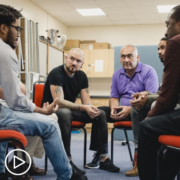
What Prostate Cancer Populations Will Benefit Most From Telemedicine? |
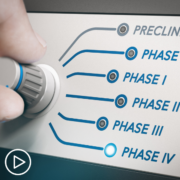
How Will Telemedicine Impact Prostate Cancer Clinical Trials? |

What Are the Benefits of Telemedicine for Prostate Cancer Patients? |
Transcript:
Dr. Leanne Burnham
Okay, my top three tips to prepare for a telemedicine visit is if you would usually have an advocate come with you to your in-person doctor’s appointment, try to make that happen for your televisit appointment as well. And explain to your physician when you get on the call say, “Hey, this is my wife, this is my husband, and they’re going to be joining the call if they have a few questions too, and I would like to have them be involved as part of the conversation.” The other thing is to have your questions prepared ahead of time, you know, and a lot of people have questions prepared ahead of time for in-person visits, but they might be nervous, they might keep their questions tucked away, well, this way your questions can be on the table next to you. Your doctor doesn’t even know, you still get to ask those questions though, and then the third tip that I would have is to allow for technology to mess up. So, for your visits, a lot of times your physician may give you a window where they say, “We’re going to call you between such and such time,” such as such time, you just sitting there waiting for them to call. But I say give yourself even more time than that in case you know something’s going on with your Internet or you are just not able to log into the app well, because I did have that happen to me personally, one time with the physician, and they were trying to get ahold of me, and I was having trouble connecting, and then he emailed me later saying, “You missed our appointment.”
I really wasn’t trying to miss the appointment, so just give yourself that extra time to get your technology together.
Will Telemedicine Improve My Quality of Life with CLL?
Will Telemedicine Improve My Quality of Life with CLL? from Patient Empowerment Network on Vimeo.
How do chronic lymphocytic leukemia (CLL) patients and care partners feel about the impact of telemedicine on quality of life? Watch as a CLL patient and care partner, Bob and Susan, discuss how easier access to blood test results affects patient emotions before and during remote office visits.
See More From the CLL TelemEDucation Empowerment Resource Center
Related Resources:

Will Telemedicine Be a Long-Term Survivorship Tool for CLL Patients? |

Is Remote Monitoring for CLL Patients on CAR T Therapy the Future? |

|
Transcript:
Susan Bottega:
The role of telemed in terms of survivorship I think is a very, very interesting subject. CLL patients are living a very long life these days with the onset of the novel agents that are coming out. Quality of life becomes a very, very important subject for CLL patients. So much of their quality of life is diminished by the visits that they have to make into doctors’ offices.
The anguish that they spend the day before, the sleepless night that accompanies the doctor’s visit. I think that this is extremely important. You’re looking very possibly of at least two days taken out of your life, and if you’re making these visits on a monthly basis or bi-monthly basis or even tri-monthly basis, that’s a long period of time to take out of the span of your lifetime. And as we’re living longer, this becomes more and more important.
You want to have that quality of life, you want to be able to go on vacations. Your vacations can’t be postponed because you have a doctor’s appointment looming in the future. You can take your computer right along on vacation with you and share your vacation with your doctor.
Bob Bottega:
I like that.
Susan Bottega:
I think the anguish that you feel about blood tests is diminished by it. You don’t have to wait to get the results of your blood tests, your blood tests pop right up on your patient portal. You don’t have to sit there and wait in a doctor’s office until you see those results.
Once you see your doctor, you’ve already got your results and you’re calm about it, you’re relaxed because you know what the results are and you can discuss them without having to deal with the anxiety that comes with hearing, “Okay, my white blood cell count has gone up considerably, so how do I calm myself down to discuss this intelligently at this point in time when I’m emotionally so upset over it?” I think these are very, very important things about the quality of your life. How about you, Bob?
Bob Bottega:
I think you said it all.
Susan Bottega:
Don’t I always? (laughter)


